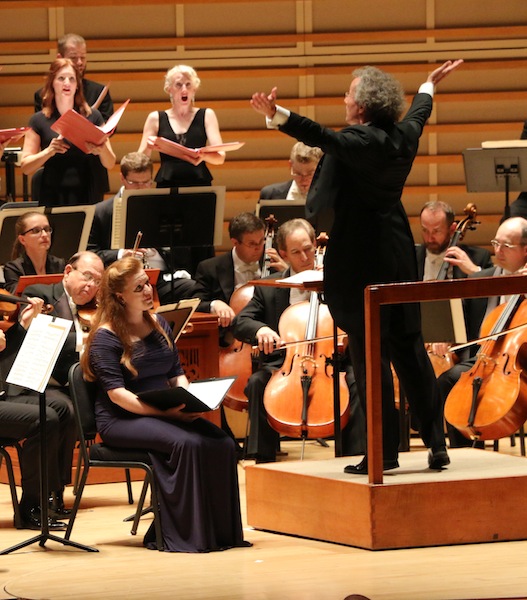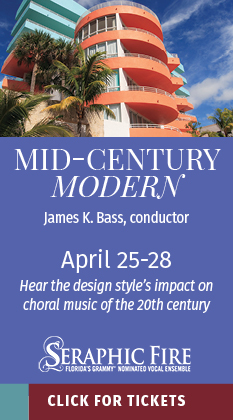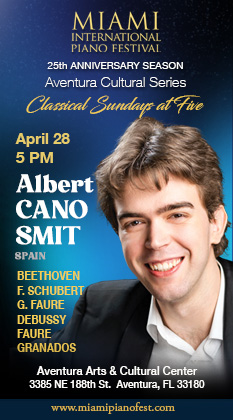Cleveland Orchestra, Seraphic Fire ascend the heights with Bach and Bruckner

Franz Welser-Möst conducted music of Bach with Seraphic Fire, the Cleveland Orchestra and soloist Jennifer Johnson Cano Friday night at the Arsht Center. Photo: Justin Holden
The pairing of the Cleveland Orchestra and Seraphic Fire with music by Bach and Bruckner drew a large audience to the Arsht Center on Friday night and the combined musical forces, each performing their signature repertory, did not disappoint.
Choral works of Johann Sebastian Bach have been central to the programming of Patrick Quigley’s outstanding choral group. The massive symphonies of Anton Bruckner have been a house specialty in Cleveland during Franz Welser-Möst’s musical directorship. With both ensembles in top form, the evening proved one of the Clevelanders’ finest concerts in ten years of Miami residencies.
The program’s first half comprised a complete Bach cantata and choruses from two others played without pause as one large musical canvas. Seraphic Fire’s complement of twenty-five voices, nearly twice as large as its usual forces, stood directly behind the reduced Cleveland Orchestra forces.
The opening and closing choruses of this segment offered music that Bach later recycled for the Mass in B minor, his late masterpiece. Two trumpets, timpani and strings set the joyous mood of “Gloria in excelsis Deo”from Cantata No. 191. The choir’s projection over the orchestra was clear and resounded throughout the Knight Concert Hall. In the five-part fugue of the contrasting second section, Seraphic Fire’s unique sonority and vocal blend potently came to the fore.
The Cantata No. 34, O ewiges Feuer, o Ursprung der Liebe, (O eternal fire, o source of love) is prime Bach with the central mezzo-soprano aria one of his finest vocal inspirations. The choir’s first entrance was marked by tight and precise ensemble singing and Bach’s weaving of overlapping vocal lines was rendered with spot-on clarity.
Welser-Möst demonstrated a fine sense of Baroque style with taut tempos and fine balancing of instrumental and vocal components. In recitatives, Steven Soph’s excellent lyric tenor and James K. Bass’ firm and voluminous bass were pillars of strength. The central aria “Wohl euch, ihr auserwähiten dir” (Wise is he who has selected you). was superbly sung by Jennifer Johnson Cano. Her range was wide with low notes free of vibrato or unsteadiness. Cano’s lovely mezzo timbre, affinity for Baroque style and emotional projection of the text were a real luxury. Marisela Sager’s elegantly tailored flute obbligato was a delight to hear.
The sublime melody of the chorus “Wir danken dir, Gott” (We thank you God) from Cantata No. 29 is better known as the concluding “Dona nobis pacem” of the B minor Mass. Sung and played with serene beauty, this Bach gem was an appropriate conclusion to this first collaboration between Miami’s splendid chamber choir and one of America’s finest orchestras.
It has taken a decade for Welser-Möst to bring his Bruckner to Miami, but the performance of the Symphony No. 7 in E Major was one of the conductor and orchestra’s best offerings to date.
Welser-Möst is a master of Bruckner’s vast musical structures, with pacing that was unhurried but never stodgy. Drawing thrilling playing from all sections of the orchestra, he demonstrated innate command of Bruckner’s symphonic architecture and building blocks of sound. While the composer’s spiritual depth was not ignored, this performance perfectly balanced the music’s fierce vigor and lyricism. The big climaxes were scaled with impressive corporate power.
Silky string textures and depth of sound from the brass were matched by warm, cleanly articulated winds. Principal flutist Joshua Smith’s many solos were particularly beautiful in tone and rhythmic acuity.
As Bruckner surely intended, the Adagio was deeply moving, spun by Welser-Möst as one long threnody. A mighty blend of horns and dark-toned Wagner tubas with cymbal and timpani crashes in the climax was stirring. The Scherzo emerged as a frantic dance with the trio section given just the proper amount of Viennese schmaltz.
In a fleet final movement, Welser-Möst brought out the shimmering wind writing which often gets lost in overblown performances. The build up to the final pages was intense and inexorable. This Bruckner performance displayed a world- class orchestra at its best and was definitely worth waiting for. Played before a rapt and attentive audience, hopefully it was a harbinger of more Bruckner symphonies to come.
The Cleveland Orchestra repeats the program 8 p.m. Saturday at the Arsht Center in Miami. arshtcenter.org
Seraphic Fire presents Bach’s Six Motets 7:30 p.m. February 17 at First United Methodist Church in Coral Gables, 7: 30 p.m. February 18 at All Saints Episcopal Church in Ft. Lauderdale and February 19 at Vanderbilt Presbyterian Church in Naples. seraphicfire.org
Posted in Performances
One Response to “Cleveland Orchestra, Seraphic Fire ascend the heights with Bach and Bruckner”
Leave a Comment
Sat Jan 28, 2017
at 12:49 pm
1 Comment





Posted Jan 28, 2017 at 2:29 pm by Nikolaus Forkel
I’m sorry, I read your reviews fairly religiously without complaint, but this time I must speak up.
Yes, the opening chorus of BWV 29 was later used (twice) in the B Minor Mass, but the chorus taken from BWV 191 was not recycled “into”, but was recycled “from”. The Kyrie and Gloria from the B Minor Mass was composed as a “brevis” in 1733. (He only added the Credo, Sanctus, Agnus Dei in 1749 with only minor alterations to the first half.) The Gloria, Domine Deus, and Cum Sancto Spiritu movements were excerpted, re-orchestrated with text resetting, and used as the cantata we know as BWV 191 as late as the early to mid 1740s. So, in fact, the mass came first.
Please take care with your scholarship. It’s actually important.